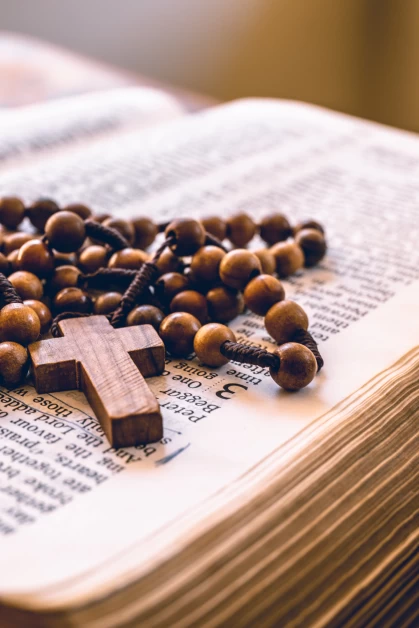Table of Contents
The Rosary holds great significance in the Catholic faith, serving as both a set of prayers and a physical object used during prayer. Its history spans centuries, and it continues to be a cherished practice among Catholics worldwide. In this article, we will explore the origins and meaning of the Rosary, its role in the apparition of Our Lady of Fatima, and the various forms it takes in contemporary Catholic devotion.
Centuries of Meaning
The exact origins of the Rosary are a topic of debate among theologians. However, many believe that it was popularized by St. Dominic de Guzman, a Spanish mystic and priest who allegedly received a vision of the Virgin Mary in 1208. According to the story, Mary presented him with the Rosary, leading to its widespread use in the Catholic Church.
The word “Rosary” refers to both the set of prayers recited and the physical object used for counting those prayers. While the Rosary is primarily associated with Catholicism, prayer beads as counting tools are common in several religions, including Islam, Hinduism, Buddhism, and Jainism.
The Catholic Church celebrates the Feast of Our Lady of the Rosary on October 7th each year. This feast was previously known as the Feast of Our Lady of Victory, commemorating a Christian victory in a naval battle in 1571. Pope Gregory XIII later changed the title of the holy day, and now the entire month of October is dedicated to the Rosary.
Praying the Rosary
To pray the Rosary, Catholics use a set of beads or knots to count and keep track of the prayers. The Rosary typically consists of five decades, with each decade containing ten beads. When touching each bead, the individual recites a Hail Mary prayer. At the end of each decade, there is a slightly larger bead, which serves as a cue to recite the Lord’s Prayer and meditate on one of the twenty mysteries, significant events in the life of Jesus and Mary.
The Rosary begins with the recitation of the Apostles’ Creed, which outlines the basics of Christian faith. It is followed by the recitation of the Lord’s Prayer, Hail Marys, and the Glory Be to the Father prayer. The Rosary concludes with the Hail, Holy Queen prayer to Mary.
The Rosary can be recited individually or in groups. Many Catholics pray the Rosary daily, using it as a means to thank God or to seek intercession for healing or protection for loved ones. It is a deeply personal and powerful prayer practice for many believers.
The Apparition of Our Lady of Fatima
One of the most famous moments in modern Catholicism is the apparition of Our Lady of Fatima. According to the account, the Virgin Mary appeared to three Portuguese children in 1917 during a time when the world was engulfed in World War I. Over a series of six appearances, Mary emphasized to these young shepherds the importance of praying the Rosary daily as a means to bring peace.
This apparition at Fatima further deepened the devotion to the Rosary within the Catholic Church. The message of peace and the call to pray the Rosary resonated with millions of faithful Catholics around the world, especially during times of conflict and turmoil.
The Evolution of the Rosary
The Rosary has evolved over time, with various materials and designs used to create the physical beads. The Marian Library at the University of Dayton houses a collection of nearly 900 unique rosaries, each with its own story and significance.
Some rosaries in the collection are made from fragrant materials such as peach pits or dried rose petals. Others are souvenirs brought back from pilgrimage sites, containing drops of holy water from sacred springs. There are even rosaries made from natural materials like seeds, olive pits, or seashells. Each rosary reflects the personal devotion and regional traditions of the individuals who owned them.
Contemporary Forms of the Rosary
In the 21st century, new inventions have emerged to make praying the Rosary more convenient for busy individuals. The Archdiocese of New York, for example, designed the Traveler’s Rosary, which is a flat piece of metal with raised beads. It comes with a case that can also hold a transportation ticket, allowing commuters to carry it with ease.
Another innovation is the Recording Rosary, which uses a dial to keep track of progress. The beads are placed on the dial, and a small arrow points to the proper place, enabling the person praying to resume where they left off after an interruption. Additionally, the Rosary emits a subtle sound at the completion of each decade, providing audio cues for the prayer.
In 2019, a church group launched the “Click to Pray eRosary,” a wearable device that connects with a phone app to assist users in learning how to pray the Rosary. This digital adaptation of the Rosary aims to engage young people in a world where technology plays a significant role in their lives.
The Significance of the Rosary Today
The Rosary remains a cherished practice for Catholics worldwide. Whether made from traditional materials or modern innovations, the Rosary serves as a powerful means of connecting with God and seeking the intercession of the Virgin Mary. It is a prayer of devotion, reflection, and deep spiritual contemplation.
As Catholics pray the Rosary, they find solace, peace, and a sense of unity with the Church and with believers throughout history. The Rosary’s significance lies not only in its historical roots and devotional practices but also in its ability to foster a personal relationship with God and to bring comfort and hope to the faithful.
In conclusion, the Rosary holds immense significance in Catholicism. It is both a set of prayers and a physical object used during prayer. Its origins are debated, but its popularity can be attributed in part to St. Dominic de Guzman. The Rosary’s importance was further emphasized through the apparition of Our Lady of Fatima, where Mary called for daily Rosary prayers to bring peace. The Rosary has evolved over time, and today, new inventions aim to make it more accessible to busy individuals. However, its core purpose and power remain unchanged. The Rosary continues to be a cherished practice, offering a means of spiritual connection, reflection, and intercession for Catholics worldwide.

